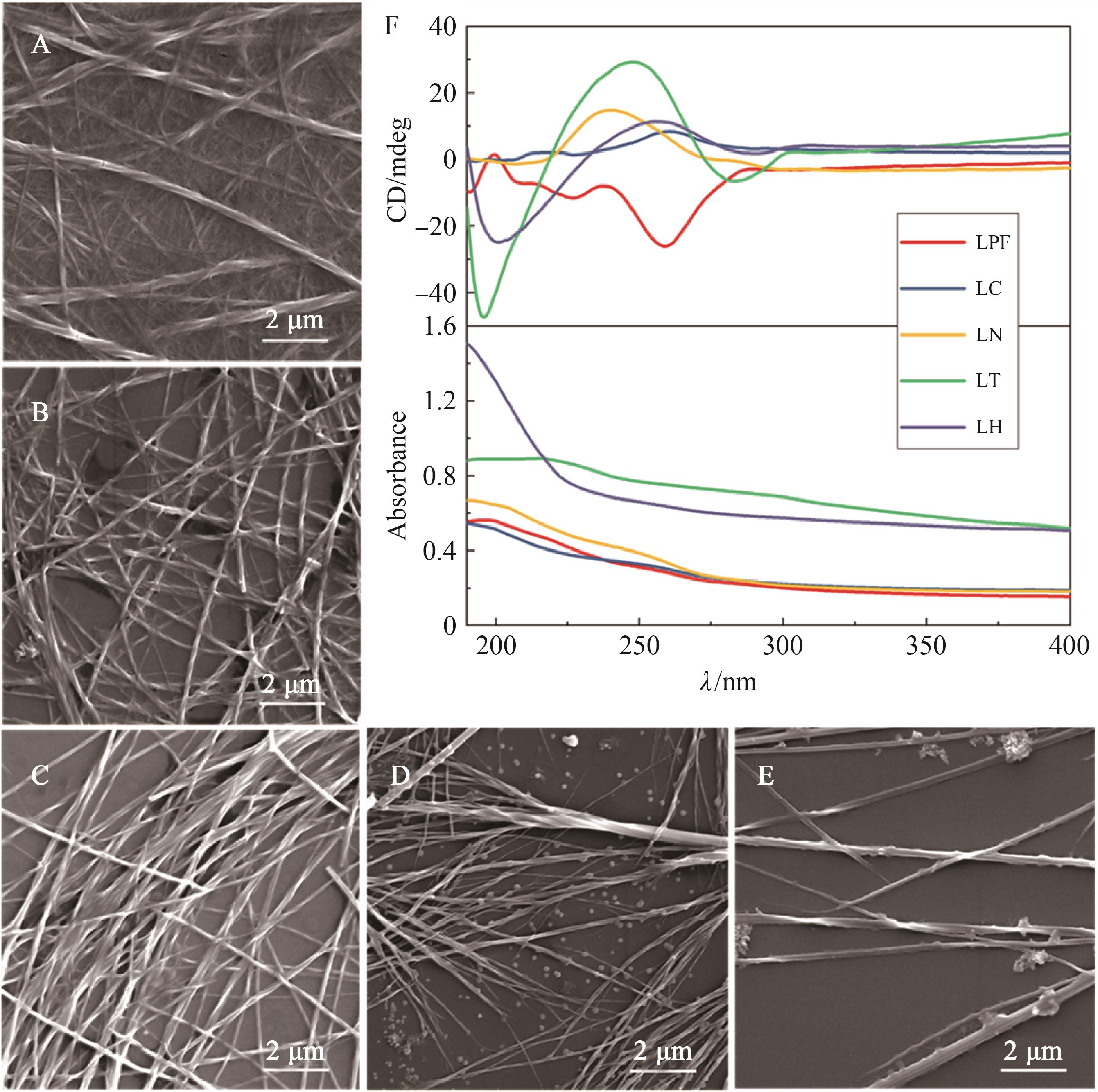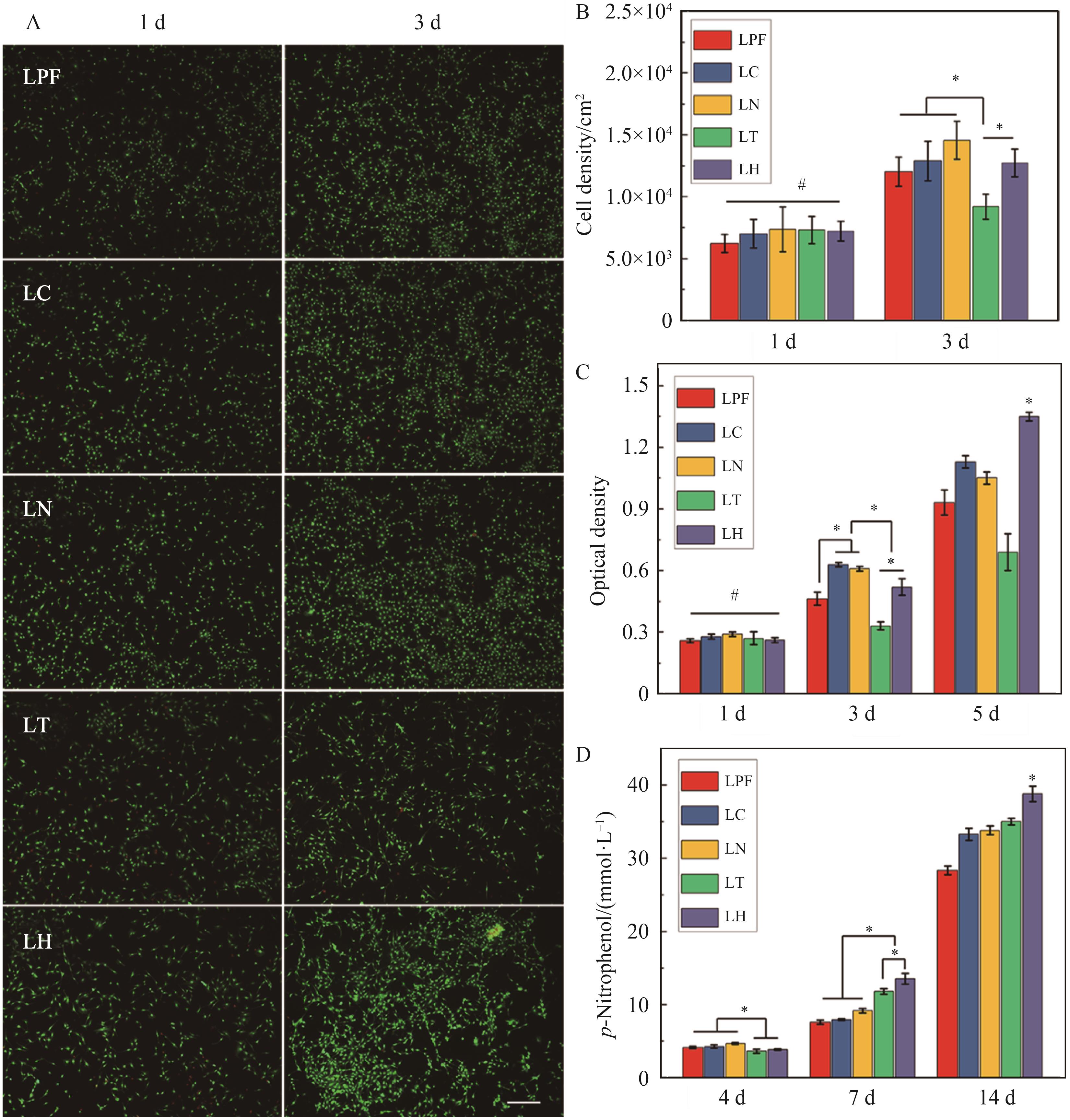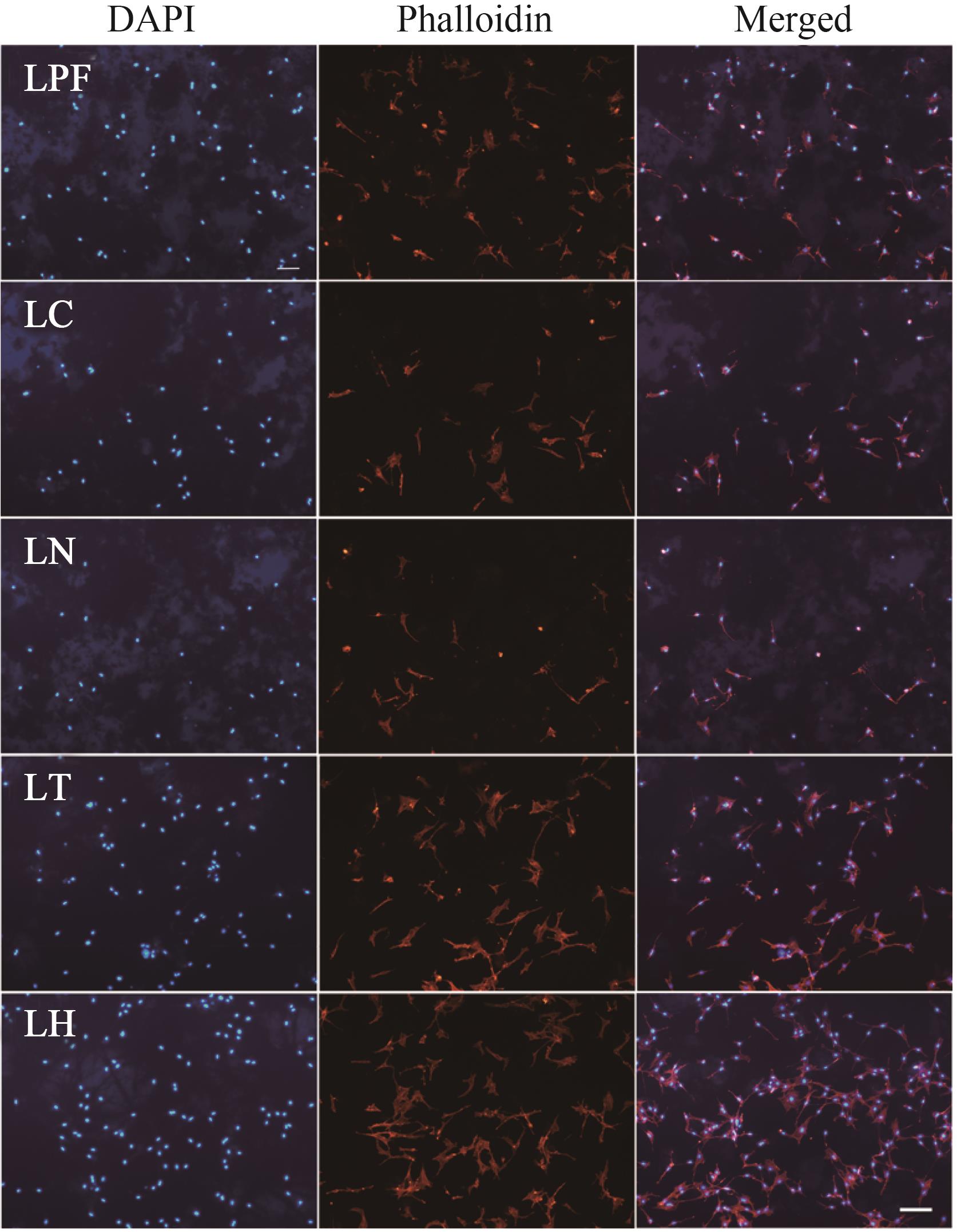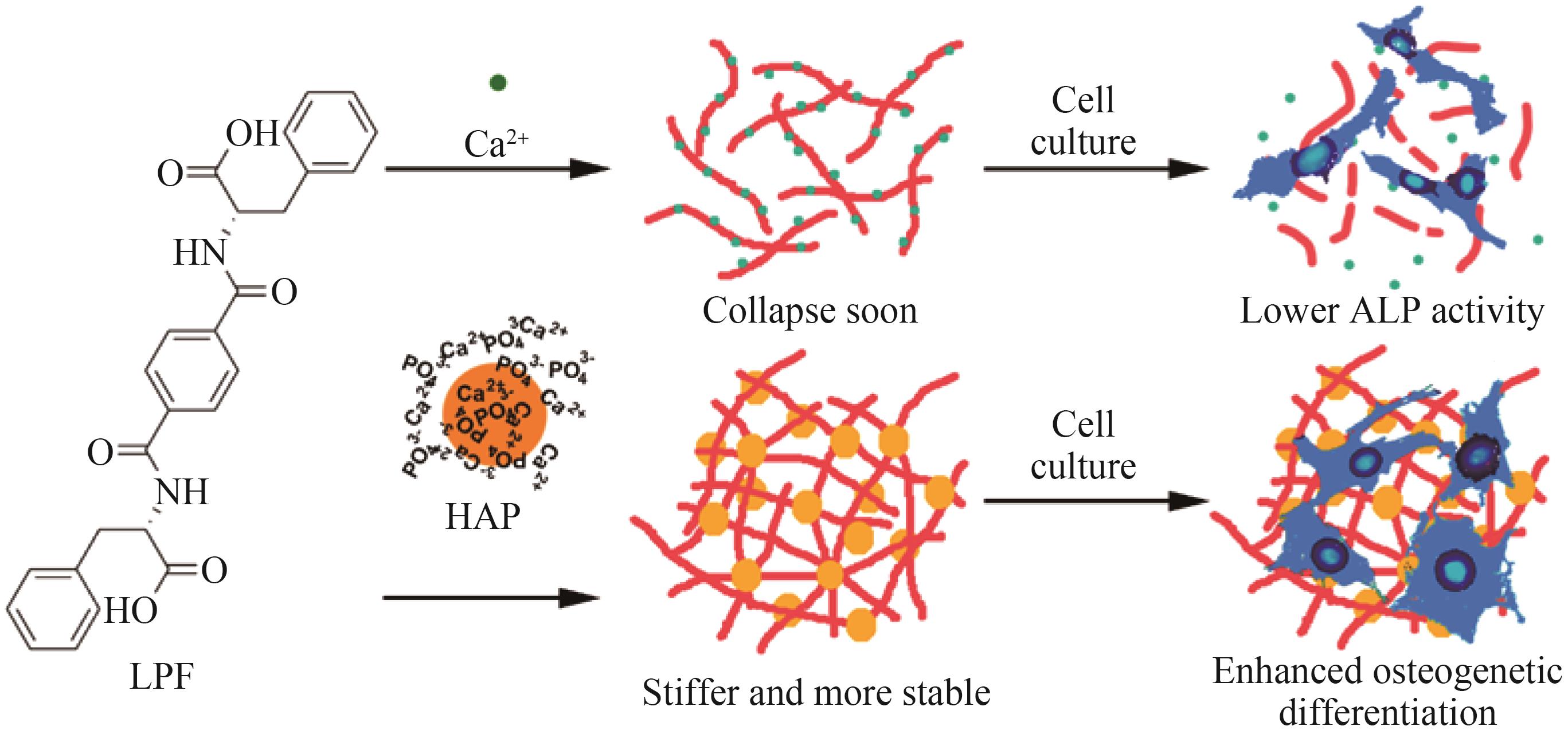
Chinese Journal of Applied Chemistry ›› 2022, Vol. 39 ›› Issue (1): 177-187.DOI: 10.19894/j.issn.1000-0518.210487
• Full Papers • Previous Articles Next Articles
High Mechanical Stability and Osteogenesis of Chiral Supramolecular Hydrogel Induced by Inorganic Nanoparticles
ZHAO Chang-Li( ),QIN Ming-Gao,DOU Xiao-Qiu,FENG Chuan-Liang(
),QIN Ming-Gao,DOU Xiao-Qiu,FENG Chuan-Liang( )
)
- State Key Laboratory of Metal Matrix Composites,School of Materials Science and Engineering,Shanghai Jiao Tong University,Shanghai 200240,China
-
Received:2021-09-30Accepted:2021-11-16Published:2022-01-01Online:2022-01-10 -
Contact:Chang-Li ZHAO,Chuan-Liang FENG -
About author:clfeng@sjtu.edu.cn; zcl@sjtu.edu.cn
-
Supported by:the National Natural Science Foundation of China(51833006);the Natural Science Foundation of Shanghai Municipality(19ZR1425400);the Science and Technology Innovation Action Plan of Shanghai Science and Technology Commission(19441903000)
CLC Number:
Cite this article
ZHAO Chang-Li, QIN Ming-Gao, DOU Xiao-Qiu, FENG Chuan-Liang. High Mechanical Stability and Osteogenesis of Chiral Supramolecular Hydrogel Induced by Inorganic Nanoparticles[J]. Chinese Journal of Applied Chemistry, 2022, 39(1): 177-187.
share this article
Add to citation manager EndNote|Ris|BibTeX
URL: http://yyhx.ciac.jl.cn/EN/10.19894/j.issn.1000-0518.210487

Fig.1 SEM images of LPF (A), LC (B), LN (C), LT (D), LH (E) xerogels; CD spectra of the hydrogels indicate signal inversion of LH around 260 nm compared to LPF (F)

Fig.2 Photograph images of the hydrogels right after hydrogel formation (A) 24 hours after hydrogel formation(B), and the rheological measurements of hydrogel samples for frequency sweep (C)

Fig.4 (A) Fluorescence microscopy images of the live and dead MC3T3-E1 cells after culture for 1 day and 3 days on different substrates(Scale bar: 100 μm); (B) Calculated cell density according to the live-dead staining images; (C) Optical density results of the CCK-8 test after incubation for 1, 3 and 5 days on different substrates; (D) ALP activity (* denotes P < 0.05)

Fig.5 Fluorescence microscopy images of MC3T3-E1 cells after 1 day cultured on LPF, LC, LN, LT and LH substrates. Cell nucleus was stained in blue; cytoskeleton was stained in red (Scale bar = 40 μm)
| 1 | STENDAHL J C, RAO M S, GULER M O, et al. Intermolecular forces in the self-assembly of peptide amphiphile nanofibers[J]. Adv Funct Mater, 2006, 16: 499-508. |
| 2 | DOU X, MEHWISH N, ZHAO C, et al. Supramolecular hydrogels with tunable chirality for promising biomedical applications[J]. Acc Chem Res, 2020, 53(4): 852-862. |
| 3 | ZHANG L, WANG T, SHEN Z, et al. Chiral nanoarchitectonics: towards the design, self-assembly, and function of nanoscale chiral twists and helices[J]. Adv Mater, 2016, 28: 1044-1059. |
| 4 | KIM S, REGITSKY A U, SONG J, et al. In situ mechanical reinforcement of polymer hydrogels via metal-coordinated crosslink mineralization[J]. Nat Commun, 2021,12: 667, 1-10 |
| 5 | YE X, CAPEZZA A J, XIAO X, et al. Protein nanofibrils and their hydrogel formation with metal ions[J]. ACS Nano, 2021, 15: 5341-5354. |
| 6 | WANG J, SHAO F, LI W, et al. Metal-ion-mediated supramolecular assembly of C3-peptides[J]. Chem Asian J, 2017, 12: 497-502. |
| 7 | SARKER M, IZADIFAR M, SCHREYER D, et al. Influence of ionic crosslinkers (Ca2+/Ba2+/Zn2+) on the mechanical and biological properties of 3D bioplotted hydrogel scaffolds[J]. J Biomater Sci Polym E, 2018, 29: 1126-1154. |
| 8 | SHAO C, CHANG H, WANG M, et al. High-strength, tough, and self-healing nanocomposite physical hydrogels based on the synergistic effects of dynamic hydrogen bond and dual coordination bonds[J]. ACS Appl Mater Interfaces, 2017, 9: 28305-28318. |
| 9 | YANG J, XU F, HAN C R. Metal ion mediated cellulose nanofibrils transient network in covalently cross-linked hydrogels: mechanistic insight into morphology and dynamics[J]. Biomacromolecules, 2017, 18: 1019-1028. |
| 10 | JANG J, SEOL Y J, KIM H J, et al. Effects of alginate hydrogel cross-linking density on mechanical and biological behaviors for tissue engineering[J]. J Mech Behav Biomed, 2014, 37: 69-77. |
| 11 | LEI Y, ZHANG G, JIANG H, et al. Synergistic toughening of nanocomposite hydrogel based on ultrasmall aluminum hydroxide nanoparticles and hydroxyapatite nanoparticles[J]. Polym Compos, 2019, 40: 942-951. |
| 12 | XU B, ZHENG P, GAO F, et al. A mineralized high strength and tough hydrogel for skull bone regeneration[J]. Adv Funct Mater, 2017, 27: 1604327, 1-9. |
| 13 | LI Q, BARRETT D G, MESSERSMITH P B, et al. Controlling hydrogel mechanics via bio-inspired polymer-nanoparticle bond dynamics[J]. ACS Nano, 2015, 10: 1317-1324. |
| 14 | ZHANG K, FENG Q, XU J, et al. Self-aassembled injectable nanocomposite hydrogels stabilized by bisphosphonate-magnesium (Mg2+) coordination regulates the differentiation of encapsulated stem cells via dual crosslinking[J]. Adv Funct Mater, 2017, 27: 1701642, 1-11. |
| 15 | DANNERT C, STOKKE B T, DIAS R S. Nanoparticle-hydrogel composites: from molecular interactions to macroscopic behavior[J]. Polymers, 2019, 11: 275, 1-35. |
| 16 | FANG J, LI P, LU X, et al. A strong, tough, and osteoconductive hydroxyapatite mineralized polyacrylamide/dextran hydrogel for bone tissue regeneration[J]. Acta Biomater, 2019, 88: 503-513. |
| 17 | GETACHEW B A, KIM S R, KIM J H. Improved stability of self-healing hydrogel pore-filled membranes with ionic cross-links[J]. J Membr Sci, 2018, 553: 1-9. |
| 18 | WANG F, FENG C. Metal-ion-mediated supramolecular chirality of L-phenylalanine based hydrogels[J]. Angew Chem Int Ed, 2018, 57: 5655-5659. |
| 19 | REJA A, BISWAS A, YADAV J, et al. Induction of supramolecular helical handedness in a chemical reaction directed self-healable soft material[J]. ChemistrySelect, 2017, 2: 10984-10989. |
| 20 | FARUQ O, KIM B, PADALHIN A R, et al. A hybrid composite system of biphasic calcium phosphate granules loaded with hyaluronic acid-gelatin hydrogel for bone regeneration[J]. J Biomater Appl, 2017, 32: 433-445. |
| 21 | ZHOU X, JIN Q, ZHANG L, et al. Self-assembly of hierarchical chiral nanostructures based on metal-benzimidazole interactions: chiral nanofibers, nanotubes, and microtubular flowers[J]. Small, 2016, 12: 4743-4752. |
| 22 | WEI Q, LU J, WANG Q, et al. Novel synthesis strategy for composite hydrogel of collagen/hydroxyapatite-microsphere originating from conversion of CaCO3 templates[J]. Nanotechnology, 2015, 26: 115605, 1-8. |
| 23 | WANG X, SCHODER H C, MULLER W E G. Amorphous polyphosphate, a smart bioinspired nano-/bio-material for bone and cartilage regeneration: towards a new paradigm in tissue engineering[J]. J Mater Chem B, 2018, 6: 2385-2412. |
| 24 | GRIGORJEVA L, MILLERS D, SMITS K, et al. Characterization of hydroxyapatite by time-resolved luminescence and FTIR spectroscopy[J]. IOP Conf Ser: Mater Sci Eng, 2013, 49: 012005, 1-4. |
| 25 | QUINLAN E, THOMPSON E M, MATSIKO A, et al. Long-term controlled delivery of rhBMP-2 from collagen-hydroxyapatite scaffolds for superior bone tissue regeneration[J]. J Control Release, 2015, 207: 112-119. |
| 26 | SATTARY M, RAFIENIA M, KAZEMI M, et al. Promoting effect of nano hydroxyapatite and vitamin D3 on the osteogenic differentiation of human adipose-derived stem cells in polycaprolactone/gelatin scaffold for bone tissue engineering[J]. Mater Sci Eng C, 2019, 97: 141-155. |
| 27 | YE H, ZHU J, DENG D, et al. Enhanced osteogenesis and angiogenesis by PCL/chitosan/Sr-doped calcium phosphate electrospun nanocomposite membrane for guided bone regeneration[J]. J Biomater Sci Polym Ed, 2019, 30: 1505-1522. |
| 28 | DING X, LI X, LI C, et al. Chitosan/dextran hydrogel constructs containing strontium-doped hydroxyapatite with enhanced osteogenic potential in rat cranium[J]. ACS Biomater Sci Eng, 2019, 5: 4574-4586. |
| 29 | YAO X, HU Y, CAO B, et al. Effects of surface molecular chirality on adhesion and differentiation of stem cells[J]. Biomaterials, 2013, 34: 9001-9009. |
| 30 | LIU G F, ZHU L Y, JI W, et al. Inversion of the supramolecular chirality of nanofibrous structures through co-assembly with achiral molecules[J]. Angew Chem Int Ed, 2016, 128: 2457-2461. |
| 31 | LIU J, ZHAO Y, ZHAO C, et al. Hydrogen-bonding regulated supramolecular chirality with controlled biostability[J]. Nano Res, 2021, https://doi.org/10.1007/s12274-021-3752-x. |
| 32 | LIU G F, ZHANG D, FENG C L. Control of three-dimensional cell adhesion by the chirality of nanofibers in hydrogels[J]. Angew Chem Int Ed, 2014, 126: 7923-7927. |
| 33 | WEI Y, JIANG S, SI M, et al. Chirality controls mesenchymal stem cell lineage diversification through mechanoresponses[J]. Adv Mater, 2019, 31: 1900582, 1-10. |
| 34 | ZHOU Y, LEI L, ZHANG Z, et al. Cation instructed steroidal prodrug supramolecular hydrogel[J]. J Colloid Interface Sci, 2018, 528: 10-17. |
| 35 | KOKAN Z, PERIC B, VAZDAR M, et al. Metal-induced supramolecular chirality inversion of small self-assembled molecules in solution[J]. Chem Commun, 2017, 53: 1945-1948. |
| 36 | GHOSH M, HALPERIN-STERNFELD M, GRIGORIANTS I, et al. Arginine-presenting peptide hydrogels decorated with hydroxyapatite as biomimetic scaffolds for bone regeneration[J]. Biomacromolecules, 2017, 18: 3541-3550. |
| 37 | JEONG S H, KOH Y H, KIM S W, et al. Strong and biostable hyaluronic acid-calcium phosphate nanocomposite hydrogel via in situ precipitation process[J]. Biomacromolecules, 2016, 17: 841-851. |
| 38 | BJORNOY S H, BASSETT D C, UCAR S, et al correlative spatiotemporal microscale study of calcium phosphate formation and transformation within an alginate hydrogel matrix[J]. Acta Biomater, 2016, 44: 254-266. |
| 39 | PANG L, SHEN Y, HU H, et al. Chemically and physically cross-linked polyvinyl alcohol-borosilicate gel hybrid scaffolds for bone regeneration[J]. Mater Sci Eng C, 2019, 105: 110076, 1-12. |
| 40 | NABAVINIA M, KHOSHFETRAT A B, NADERI-MESHKIN H. Nano-hydroxyapatite-alginate-gelatin microcapsule as a potential osteogenic building block for modular bone tissue engineering[J]. Mater Sci Eng C, 2019, 97: 67-77. |
| 41 | CARLES-CARNER M, SALEH L S, BRYANT S J. The effects of hydroxyapatite nanoparticles embedded in a MMP-sensitive photoclickable PEG hydrogel on encapsulated MC3T3-E1 pre-osteoblasts[J]. Biomed Mater, 2018, 13: 045009, 1-11. |
| 42 | JACKSON W M, JAASMA M J, TANG R Y, et al. Mechanical loading by fluid shear is sufficient to alter the cytoskeletal composition of osteoblastic cells[J]. Am J Physiol Cell Ph, 2008, 295: C1007-C1015. |
| 43 | DANG-I A Y, KOUSAR A, LIU J, et al. Mechanically stable C2-phenylalanine hybrid hydrogels for manipulating cell adhesion[J]. ACS Appl Mater Interfaces, 2019, 11: 28657-28664. |
| 44 | KHATIWALA C B, PEYTON S R, PUTNAM A J. Intrinsic mechanical properties of the extracellular matrix affect the behavior of pre-osteoblastic MC3T3-E1 cells[J]. Am J Physiol Cell Ph, 2006, 290: C1640-C1650. |
| 45 | MURPHY C M, MATSIKO A, HAUGH M G, et al. Mesenchymal stem cell fate is regulated by the composition and mechanical properties of collagen-glycosaminoglycan scaffolds[J]. J Mech Behav Biomed, 2012, 11: 53-62. |
| 46 | ROGINA A, RESSLER A, MATIC I, et al. Cellular hydrogels based on pH-responsive chitosan-hydroxyapatite system[J]. Carbohydr Polym, 2017, 166: 173-182. |
| 47 | ROGINA A, ANTUNOVIC M, PRIBOLSAN L, et al. Human mesenchymal stem cells differentiation regulated by hydroxyapatite content within chitosan-based scaffolds under perfusion conditions[J]. Polymers, 2017, 9: 387, 1-17. |
| 48 | RESSLER A, RODENAS-ROCHINA J, IVANKOVIC M, et al. Injectable chitosan-hydroxyapatite hydrogels promote the osteogenic differentiation of mesenchymal stem cells[J]. Carbohydr Polym, 2018, 197: 469-477. |
| 49 | LIU J, YUAN F, MA X, et al. The cooperative effect of both molecular and supramolecular chirality on cell adhesion[J]. Angew Chem Int Ed, 2018, 57: 6475-6479. |
| 50 | DOU X, WU B, LIU J, et al. Effect of chirality on cell spreading and differentiation: from chiral molecules to chiral self-assembly[J]. ACS Appl Mater Interfaces, 2019, 11: 38568-38577. |
| [1] | Yu-Jie MA, Ying-Xin ZHANG, Huan-Yan DAI, Zhi-Min XU, Bing HAN. Preparation and Properties of 3D Printed nHA/PEEK-AgNPs Composite Porous Scaffolds [J]. Chinese Journal of Applied Chemistry, 2023, 40(4): 536-545. |
| [2] | Chun-Mei ZHAO, Xiu-Miao ZHOU, Xi-Xi JIN, Yu-Hang WANG, Yi-Jing DANG. Preparation of Saddle-Shaped Cyclooctatetrathiophene-Based Hybrid Nanomaterials and Fluorescence Properties [J]. Chinese Journal of Applied Chemistry, 2022, 39(02): 283-288. |
| [3] | Zhao-Yong ZHANG, Qian LI, Da-Lin WANG, Jiang-Lin FANG, Dong-Zhong CHEN. Controlled Synthesis and Photophysical Properties of Liquid Crystalline Diblock Copolymers with Side⁃Chain Discotic Triphylene and Calamitic Azobenzene Mesogens [J]. Chinese Journal of Applied Chemistry, 2021, 38(10): 1340-1352. |
| [4] | Zhao-Yong ZHANG, Qian LI, Da-Lin WANG, Jiang-Lin FANG, Dong-Zhong CHEN. Controlled Synthesis and Photophysical Properties of Liquid Crystalline Diblock Copolymers with Side⁃Chain Discotic Triphylene and Calamitic Azobenzene Mesogens [J]. Chinese Journal of Applied Chemistry, 2021, 38(10): 0-0. |
| [5] | QIAN Jin, HAO Yanzhong, LI Jingqi, PEI Juan, LI Yingpin. Preparation of TiO2 Branched Nanorod Array to Improve the Performance of Polymer Hybrid Solar Cell [J]. Chinese Journal of Applied Chemistry, 2020, 37(6): 695-702. |
| [6] | SHE Xiaohong, DU Juan, WANG Lupei, ZHU Wenli, YANG Qiaoling, ZOU Chihui. Preparation and Properties of Tough Polyvinyl/Polyaniline/Polypyrrole/TiO2 Conductive Hybrid Hydrogel [J]. Chinese Journal of Applied Chemistry, 2020, 37(5): 541-546. |
| [7] | HU Jiale, XUE Dongfeng. Research Progress on the Characteristics of Rare Earth Ions and Rare Earth Functional Materials [J]. Chinese Journal of Applied Chemistry, 2020, 37(3): 245-255. |
| [8] | SUN Xiaotong,CHEN Nan,LIANG Hanxue,LI Zengling,LIU Qianwen,QU Liangti. Progress of Fabrication of One-Dimensional Hybrid Nanomaterials by Template-Confined Growth and Their Diverse Applications [J]. Chinese Journal of Applied Chemistry, 2020, 37(2): 123-133. |
| [9] | DANG Lifang,WANG Ruixin,XIE Meina,JIAO Weizhou. Research Progress of Polyoxometalates and Their Self-aggregation Behaviors in Solution [J]. Chinese Journal of Applied Chemistry, 2018, 35(6): 625-644. |
| [10] | YU Chang,SHAO Shuai,LI Hejie,LIU Guofeng,DING Binbin,MA Ping'an,LIN Jun. Upconversion Nanoparticles Decorated with Hybridization Chain Reaction DNA for Near-infrared Light Controlled Release Doxorubicin [J]. Chinese Journal of Applied Chemistry, 2018, 35(12): 1485-1491. |
| [11] | YU Chang, SHAO Shuai, LI Hejie, LIU Guofeng, DING Binbin, MA Ping'an, LIN Jun. Upconversion Nanoparticles Decorated with Hybridization Chain Reaction DNA for Near-infrared Light Controlled Release Doxorubicin [J]. Chinese Journal of Applied Chemistry, 2018, 35(12): 0-0. |
| [12] | DAI Yanfeng,ZHANG Zhiqiang,LIU Yipeng,MA Dongge. High Efficiency Fluorescent/Phosphorescent Hybrid White Organic Light-Emitting Diodes Without Spacer Structure [J]. Chinese Journal of Applied Chemistry, 2015, 32(10): 1139-1145. |
| [13] | GUO Xianhou1,2, WNAG Xueliang1, YU Zhangyu1,3*. Determination of Epinephrine by Graphene/Platinum Nanoparticle Hybrid Membrane Modified Electrode [J]. Chinese Journal of Applied Chemistry, 2014, 31(12): 1465-1471. |
| [14] | LUO Qimei, WANG Huixian, LIU Dengyou*. Simultaneous Determination of Catechol and Hydroquinone Based on Gold Electrode Modified with Carbon Nanotubes-graphene Nanosheet Hybrid Films [J]. Chinese Journal of Applied Chemistry, 2014, 31(08): 983-989. |
| [15] | HUANG Zengfang*, QU Xiaoyue, MA Junxian. Synthesis, Characterization and Properties of the Hybrid Latexes of Polyurethane and Polystyrene-acrylate and Their Application in Laminating Adhesive [J]. Chinese Journal of Applied Chemistry, 2013, 30(12): 1404-1410. |
| Viewed | ||||||
|
Full text |
|
|||||
|
Abstract |
|
|||||

